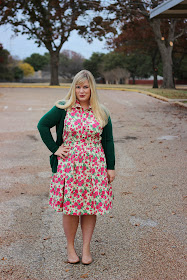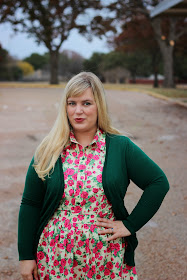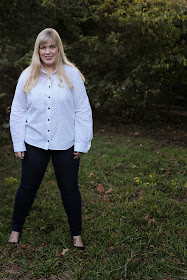When planning a dress for the holidays, a certain aesthetic comes to mind. This is the season for plaid taffetta and long-sleeved wool sheaths. This is, most assuredly, not the season for lightweight poplin printed with hot pink roses. No Northern Hemisphere woman in her right mind would sew such a thing right now.
Except, apparently, me.
I couldn't help myself. While musing on Christmas dresses, this Liberty cotton lodged itself in my mind and wouldn't budge. I've hoarded four yards of this poplin, in the pink Carline print, for years. Not only is this my favorite Liberty print, but it's also maddeningly discontinued. I have another two yards in blue, awaiting the perfect blouse pattern, and an Ebay alert set up for the red colorway. Carline is my fabric white whale.
This particular length was bought with a shirtdress in mind. Of course. Since then, McCall's 6696 has come into my life and my collar-making skills have improved tenfold. Not only would this be an ideal Christmas shirtdress, I decided, but I probably wouldn't ruin it in the process. Score! It was time for Carline to have her day.
True to form, I couldn't leave well enough alone. Heaven forbid, I take the easy way and make an unaltered, perfect-as-she-is 6696. That would be too easy, too stress-free! Instead, I decided to turn my beloved shirtdress pattern into a half-shirtdress pattern. I would use the bodice of 6696, paired with a straight waistband, full, gathered skirt, and side zip closure.
Despite my dramatics, this is actually a straight-forward pattern change. There was some basting involved, to get the waistband just right, but otherwise, it's a simple matter of planning. Let's walk through it, shall we? Note: I didn't set out to make this a tutorial, but rather a guideline of my process, so this isn't a fully photographed explanation. Writing it out, the instructions ballooned in size. I explain everything thoroughly, however, and photographed the two weird parts. If you have any questions, leave them in the comment section!
1. Cut both skirt pieces on the fold. I decided to use the original skirt pieces from 6696, but gather them like a traditional dirndl skirt. You could, similarly, cut two rectangles for a real dirndl skirt, as in Gertie's tutorial. Either way, since we're moving from a front button closure to a side zip, you're going to cut those skirt pieces on the fold, so that you don't have a seam running down the front.
2. Trace a new button band. For a half-shirtdress, you only want a button band the length of your bodice pieces. So, measure the length of your bodice center fronts, then mark that length on your button band piece. Trace that portion of your band and--voila!--new bands.
3. Measure your waistband. Your impulse for this project will be to add the length of your button band to your original waistband, to create a slightly longer one. This is actually not the way to go. Full shirtdresses have more ease around the waist than a half-shirtdress, to prevent button gaping. How much ease you want at the waist will be up to you (standard is 1'', but I prefer 1/2''), but it's likely that 6696's waistband will work as-is, without lengthening. Put the pattern piece around your natural waist and try it out! Does it feel comfortable, when you sit? Is it secure enough to add definition? Add or subtract length, based on this decision, and remember to factor in a 5/8'' seam allowance on each end.
4. Mark side seams and centers of waistband. Because we're gathering our skirts in, you'll need to mark your center front, center back, and side seams, so that your skirt is even all around. Begin by adding your seam lines to each end at 5/8'', then measure in from one end at 1/4th the length (Center Front), 1/2 the length (Side), and 3/4th the length (Center Back) between those lines.
5. (Optional) Reduce gathers on back bodice. While the blousing in the back of this dress doesn't bother me, you may want to streamline the back in this version. To do so, simply trace the back bodice piece, then remove your desired amount from between the center gathering marks, in a vertical strip from top-to-bottom. I recommend leaving some gathers in, for ease of wearing, but removing one or two inches from the pattern piece will lessen that blousing quite a bit.
6. Leave the left side bodice open, 3.5 inches from top. We're going to insert an invisible zipper on the left side, so construct your bodice normally, but only sew down part of that side seam. There's no exact science to this, but it should be enough that you'll be able to get into your dress comfortably! Remember to back-stitch, at each end. Construct and finish the rest of your bodice, as usual.
 |
| The left side of my bodice, after leaving it open. |
8. Sew the waistband to the bodice. Begin pinning with the left side, still leaving that open, and pin your waistband to the bodice. Align the centers of your front and back bodice, with the marks on your waistband, then baste them together. If you're happy after a fit-check, then sew everything in permanently! Note: you may find that you want to take the waistband in further at this step, or even raise it a little. The proportions of a half-shirtdress are just a bit different from a full, so these changes are natural.
 |
| Overlapped bodice bands attached to the waistband. |
10. Gather and attach the skirt. Sew two rows of gathering stitches, at 1/4 inch and 1/2 inch, around the entirety of the skirt waistline. Once you've sewn, push along these lines and create your gathers. Match the skirt center front, center back, and side seams to those of your waistband, and even out the gathers across the skirt. Stitch into place.
11. Insert an invisible zipper. Finish the entire left side of your dress, from bodice to skirt, using your preferred finishing method. (I serged everything, for simplicity's sake.) Then, insert the invisible zipper into the left side, with the top zipper stop aligning with your fabric opening. It's just like sewing an invisible zipper in a skirt or a dress, but the top zipper tape is going into an existing seam. Conversely, you can choose to leave the top left side entirely open beforehand, closing it only after your zipper installation. Either way, make sure your waistbands line up, and have at it!
 |
| Resulting invisible side zipper and a peek at my light pink bias tape armscye finish! |
12. Sew the left skirt seam. Once your invisible zipper is in place, sew the remaining skirt side seam, below the zipper. Secure the bottom zipper tape into this seam, with a few hand stitches.
13. Buttons and hem. Add your buttonholes, buttons, and hem, as usual!
14. Dance a jig, in your new half-shirtdress.
Of course, you could also just use an existing half-shirtdress pattern. There's the new wrapped half-shirtdress from McCall's, M7081, and the Lisette Traveler Dress from Simplicity. I didn't use either of these, because the McCall's was just published last week and the Traveler doesn't have a traditional collar construction, which drives me crazy. I figured, the 6696 already fits in the bodice, so why not go with the one I already love? A good design alteration is creatively exhilarating, anyhow!
It's okay to just nod at me, as if I've gone mad. You should use an existing pattern, if you've got one stashed away.
 Apart from the construction techniques above, there are a few little extras in this dress. As is my wont, everything is top-stitched, including the button bands, collar, collar stand, and the waistband. Not only does it cut down on the hand-stitching, but it adds a bit of definition to the busy floral pattern. The armscyes are finished with light pink single-fold bias tape, which goes with the palette nicely. I was going to make self-fabric tape, but couldn't bring myself to waste the Carline. I actually have just enough of this fabric leftover to make a sleeveless blouse. Joy!
Apart from the construction techniques above, there are a few little extras in this dress. As is my wont, everything is top-stitched, including the button bands, collar, collar stand, and the waistband. Not only does it cut down on the hand-stitching, but it adds a bit of definition to the busy floral pattern. The armscyes are finished with light pink single-fold bias tape, which goes with the palette nicely. I was going to make self-fabric tape, but couldn't bring myself to waste the Carline. I actually have just enough of this fabric leftover to make a sleeveless blouse. Joy!
The buttons on this lovely are jade green plastic, from Hancock's, and match the green of the rose leaves exactly. Honestly, y'all, as much as I love Carline, those buttons might be my favorite part of this dress. They glow like little emeralds against the rose pattern, don't they?
Of course, I'm wearing this dress with my favorite emerald cardigan right now. It's been pretty mild lately, but things are going to turn chillier this week! We're actually headed to New Orleans next weekend, to spend the holiday week (and our first anniversary!) there with my family. It's not a Danielson Family Christmas, unless we're in some far flung location, eating Chinese food and using a coat stand as a tree. What can I say? We're heathens, the lot of us.


















